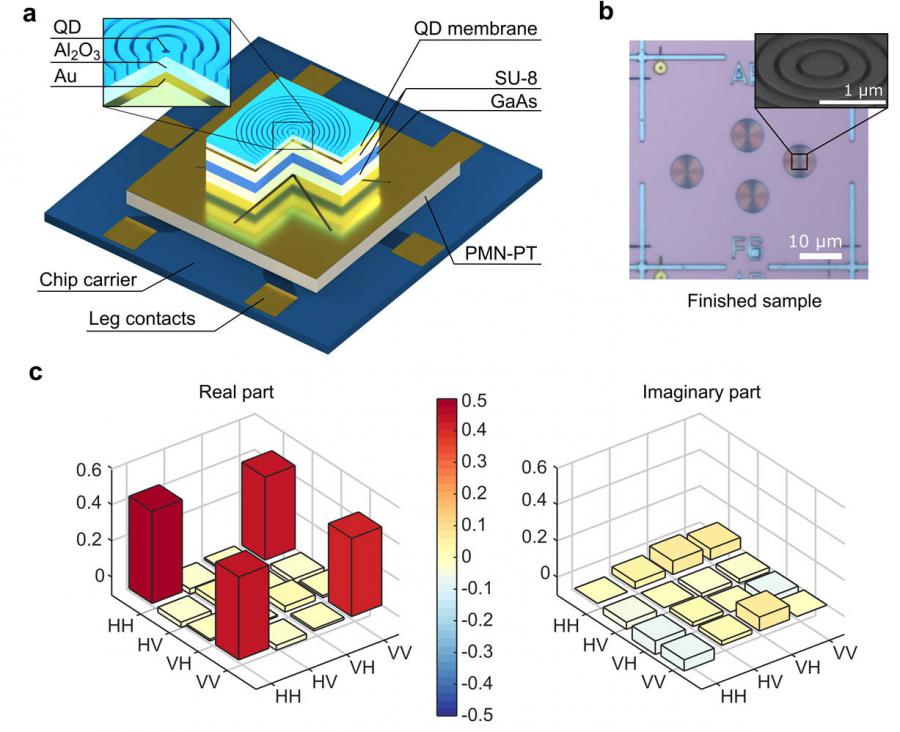
Breakthrough in quantum light source heralds ultra-secure communication
USA, August 5, 2024 /EINPresswire.com/ -- Scientists developed a new light source that creates super-bright entangled photons. These photons are crucial for ultra-secure communication in quantum networks. The source combines two technologies to achieve high brightness and entanglement, overcoming the limitations of previous methods. This paves the way for more efficient and secure quantum communication.
Imagine the possibility of sending messages that are completely impervious to even the most powerful computers. This is the incredible promise of quantum communication, which harnesses the unique properties of light particles known as photons. In quantum networks, information is encoded not only in the presence or absence of light pulses, but also in the intricate properties of the photons themselves, such as their polarization. Learn how this cutting-edge technology is revolutionizing secure communication.
A pan-European, Asian, and South American research team has developed a new light source that emits exceptionally bright, entangled photons. These special pairs of photons are the cornerstone of quantum communication, a revolutionary technology that promises ultra-secure data transmission. Unlike traditional sources, this new device overcomes limitations by achieving high brightness and entanglement, paving the way for more efficient and secure quantum networks.
A light source that can generate entangled photons is crucial for quantum communication. Entanglement is a bizarre quantum phenomenon where two photons become linked, sharing the same fate regardless of distance. If someone measures the property of one entangled photon, the other instantly reflects that change, even if they're separated by vast distances. This inherent link forms the basis for unbreakable encryption in quantum communication.
However, existing sources for entangled photons often face limitations. Traditional methods, like spontaneous parametric down-conversion (SPDC), can generate high-quality entangled photons but struggle with brightness. This means fewer entangled photons are available for communication, slowing data transfer.
Quantum emitters driven under resonant excitation offer a solution. These emitters can generate photons on demand and have the potential to be much brighter. Among these, semiconductor quantum dots (QDs) are particularly promising. However, until now, scientists haven't been able to optimize both brightness and entanglement in QD sources. They often had to choose between one or the other.
This new research addresses this challenge. The scientists created a unique device integrating a quantum dot with a special light-trapping cavity and a micromachined platform. This allows them to precisely control the properties of the light emitted by the quantum dot. By fine-tuning these properties, they achieved a breakthrough – a source that simultaneously generates bright, entangled photons.
This new source represents a significant step towards practical applications of quantum communication. Generating bright, entangled photons on-demand is essential for building secure and efficient quantum networks. These networks could revolutionize various fields, from ultra-secure communication for governments and financial institutions to unbreakable encryption for everyday transactions.
While challenges remain in achieving even higher brightness and perfect indistinguishability of the entangled photons, this research marks a significant leap forward. It demonstrates the potential of quantum dots as a reliable source for building the future of quantum communication networks.
DOI
10.1186/s43593-024-00072-8
Original Source URL
https://doi.org/10.1186/s43593-024-00072-8
Funding information
This work was supported by the European Research Council (ERC) under the European Union’s Horizon 2020 Research and Innovation Program (No. 679183 (SPQRel), 871130 (Ascent+), 899814 (Qurope) 101017733 via the project QD-E-QKD, (CSA-Coordination and support action, H2020-WIDESPREAD-2020-5), 951737 (NONGAUSS) and 101017733 via the project QD-E-QKD), the European Union's Horizon 2020 (2014–2020) under Grant Agreement No. 731473 (QuantERA project HYPER-U-P-S No. 8C18002), the MUR (Ministero dell’Università e Ricerca) through the PNRR MUR Project PE0000023-NQSTI and Project PRIN 2017 Taming complexity via Quantum Strategies a Hybrid Integrated Photonic approach (QUSHIP) Id. 2017SRNBRK, the QuantERA II Programme, the FFG (grant No. 891366), the Austrian Science Fund (FWF) via the Research Group FG5, P 29603, I 4380, I 3762, the Linz Institute of Technology (LIT), the LIT Secure and Correct Systems Lab, supported by the State of Upper Austria, the Federal Ministry of Education and Research (BMBF) through the Quantum Futur (FKZ: 13N16272) initiative, the Czech Science Foundation (grant no. 21-18545S), Palacky University (grants no. IGA-PrF-2022-005, IGA-PrF-2023-006), the National Natural Science Foundation of China (NSFC 12104090), “the Fundamental Research Funds for the Central Universities,” and “Zhishan” Scholars Programs of Southeast University.
Lucy Wang
BioDesign Research
email us here
Distribution channels: Science, Technology
Legal Disclaimer:
EIN Presswire provides this news content "as is" without warranty of any kind. We do not accept any responsibility or liability for the accuracy, content, images, videos, licenses, completeness, legality, or reliability of the information contained in this article. If you have any complaints or copyright issues related to this article, kindly contact the author above.
Submit your press release
